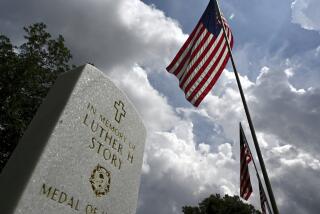One Tooth Is Heating Up MIA Debate
- Share via
WASHINGTON — When he was 11 years old, Gregory Stephen Crandall wrote a fictional account about three soldiers who died making sure that their friends lived through a battle. “The company had been saved,” the young boy wrote. “Saved to come back and pick up their sacred bodies.”
Ten years later, Crandall--a 21-year-old Army helicopter pilot during the Vietnam War--was shot down over the jungles of Laos. Now, two decades after he was listed as “killed in action, no body recovered,” the U.S. Army is bringing him back home.
This afternoon, with full military honors, all that remains of Warrant Officer Crandall will be buried in Arlington National Cemetery. And while it may close officially the long years of uncertainty over his fate, it will open new anguish for members of his family, who still cannot accept that he is dead.
Inside the flag-draped coffin will be all that was found of this soldier: one tooth.
“I’m either going to lose my sanity or lose control of my anger,” said Nancy Gourley, who has spent 23 years hoping to settle the mystery of her older brother’s disappearance.
She and other family members do not believe that one tooth proves anyone is dead. They also wonder about a process under which the U.S. government paid the Laotians for permission to survey the site where Crandall’s helicopter came down. The Americans found certain key evidence with ease. Crandall’s dog tag was lying above the surface, and four teeth--at least one of them Crandall’s--were found below ground. But there was not a trace of other remains: no skulls, bones or even bone fragments.
But Pentagon officials insist that Crandall is dead. “Whatever we can recover of the soldier, we take very seriously our obligation to bring him home,” said Shari Lawrence, an Army spokeswoman.
Disputes between the Pentagon and families of missing American servicemen from the Vietnam War are hardly new. The arguments are familiar, the accusations rote. Yet unlikely as it might seem, the dispute over Crandall’s No. 4 maxillary premolar and other unresolved cases are exposing new fissures in the debate, this time dividing the usually like-minded national support organizations for Vietnam veterans and their families.
The questions revolve around the exhaustive, $100-million-a-year Pentagon effort to excavate old battle sites in Southeast Asia in an effort to find and bring home the fragmentary remains of American war dead. The U.S. government is negotiating with Vietnam, Laos and Cambodia for any new information that could help cross out the name of yet another soldier on the list of the 2,250 still unaccounted for.
Earlier this week, President Clinton refused to lift a trade embargo against Vietnam, saying that its leaders must do more to settle the issue of missing U.S. servicemen. And at a Pentagon ceremony for national POW/MIA Recognition Day last Friday, Defense Secretary Les Aspin pledged: “Today, we are at work around the world trying to resolve that uncertainty.”
Some of the national support organizations believe that the U.S. effort should more vigorously seek to force Vietnam to turn over more records of Americans. “The Vietnamese have never been known to let go of anything,” said Ann Mills Griffiths, executive director of the National League of Families of American Prisoners and Missing in Southeast Asia. “That’s why they continue to droll out tiny bits of information.”
Others, however, want the United States to abandon the tedious hunt for remains and concentrate instead on the living who may still be held prisoner there.
“If we’ve got plenty of time to sift through the dirt to find old bones, why not put that same emphasis into the live sightings?” asked J. Thomas Burch Jr., a Green Beret in Vietnam and now a Washington lawyer and chairman of the National Vietnam Veterans Coalition.
He and others consider it absurd for the government to close out the search for a missing serviceman on the strength of just one tooth, or as in other cases, a bit of an arm bone or a leg.
It is to this divided capital that the remains of Warrant Officer Crandall return this week.
He had dark hair and green eyes and he can be seen in an old photograph taken in Vietnam, smiling under a dark mustache, waving the peace sign into the air.
He was born in Oakland, the son of a career Army officer who also served in Vietnam, and he attended schools in England and later Tacoma, Wash. He was elected president of his high school class and captain of the football team. He once was scouted by the St. Louis Cardinals baseball team, his family said.
He also fancied himself as a writer. He earned an A on the school project about the Army soldiers whose “sacred bodies” were recovered. And he cherished a turn-of-the-century poem by Thomas Hardy called “The Darkling Thrush,” wherein a “frail, gaunt and small” bird chose to “fling his soul upon the growing gloom.”
In February, 1971, Crandall’s helicopter was shot out of the sky and, after a series of seven explosions, crashed into an old bomb crater.
According to Pentagon documents, Crandall had radioed that he was under attack from the ground and “he maneuvered to evade the enemy fire.” But the records add that “his aircraft was seen to crash and catch on fire.” And, while other U.S. aircraft made several low-level passes over the site in the days that followed, their efforts to rescue any survivors or recover the dead ended “with no results.”
Although the reports seemed to provide clear evidence that Crandall was dead, they were cast in doubt by a recently unclassified Defense Information Report Evaluation of the incident. The report quotes a CIA source as having seen eight U.S. helicopters shot down about the same time and at the same location as Crandall’s aircraft, near Hill 500 in Savannakhet Province. The source also recalled that he “saw one wounded and three dead U.S. crew members” and that “later he heard that the wounded individual had died en route to a hospital.”
There, indeed, was a series of helicopter losses in that area and within that time frame. But the military could not determine which incident the source referred to and “consequently, the three dead and one wounded U.S. personnel he reportedly saw cannot be positively identified.”
But in February, 1991, a U.S. recovery team was granted access to the crash site.
Among the items found: Crandall’s dog tag; four teeth; a name tape of “Engen” belonging to Spec. 4 Robert J. Engen, also aboard the helicopter, and the nameplate from the helicopter, which was built in Culver City.
The dog tag was found lying on the surface in jungle terrain, despite two decades of tropical weather and monsoons. Equally odd is that only the helicopter nameplate and no other major aircraft parts were found. And while the teeth were beneath the surface, there were no skulls or other skeletal parts.
Gourley, Crandall’s sister, finds it equally astonishing that before the U.S. military gained access to the site, the American government agreed to build a school in Laos and provide other economic assistance, raising her suspicion that some of the material could have been “planted” at the crash site by Laotians eager to make the arrangement pay off for the United States, possibly encouraging more U.S. assistance in the future.
“The Defense Department has no right to force this on our family,” she said. “We only want to leave his case file open until we feel positive that Greg is dead.”
If the tooth were planted, the disturbing likelihood arises that Laos is holding back Crandall’s other remains, or possibly keeping him alive and hidden in a prison camp.
Maj. Steve Little, a Pentagon spokesman who specializes in MIA issues, acknowledged the possibility that remains have been tampered with by the governments in Southeast Asia. He said that situation puts the United States in a precarious position of “having to use whatever means are at our disposal” not only to identify what bones are found but also to positively discount a potential hoax.
The remaining teeth were traced to Engen and the third lost soldier, Spec. 4 Walter E. Lewellen. They were buried together in a single coffin at Arlington in November, 1991, although Lewellen’s mother said that she would have preferred that the teeth had been left in Laos.
“I think it was terribly silly,” Mildred Lewellen said this week. “If it made the Army feel good to do that, I guess it was OK. But I think they could do more for other people who might be prisoners of war over there.
“That could have been dogs’ teeth for all we know.”
Crandall’s family resisted longer, unwilling to accept a ruling of his death with such scant evidence. But their own dental consultant examined the case, and he too verified the match. The tooth has been placed inside a full-length coffin, along with a full-dress uniform and his medals: The silver star, the bronze star and the purple heart.
More to Read
Sign up for Essential California
The most important California stories and recommendations in your inbox every morning.
You may occasionally receive promotional content from the Los Angeles Times.











